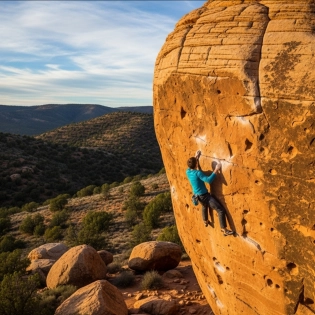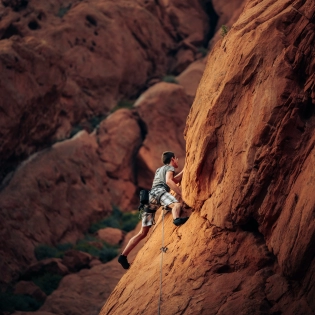








climbing shoes
Generally, no. Climbing shoes are supposed to be pretty tight.
I wear climbing shoes slightly bigger than my street shoe size, and I still cannot wiggle my toes.
I can slightly move them up and down a little, but not so much that I would consider it wiggling them.
Because we are in pain! But not that much pain. Generally, climbing shoes are not comfortable, and leaving them on for a long period of time just starts to hurt after a while. Taking them off in between some of the climbs just lets our feet relax a little bit, and delays the session-ending feet pain.
I have a pair of shoes (Mad Rock Drone HV) that I got resoled 3 times already.
Usually the people who resole it tell us when we should move on to a new shoe, which is when the old shoes cannot be resoled anymore, but they have yet to do so for mine!
I have friends who have resoled theirs just twice and were told that there probably wont be a next time, that their shoes are just too damaged overall.
It really depends on your shoes and the status of them. If areas of the shoes are damaged that are not going to be replaced or fixed in the resole, then resoling obviously wont help them. As for the amount of time a climbing shoes can be resoled though, as I mentioned, mine have gone for 3 resoles, and will probably go fro at least one more, my friends have gone for just 2 and will probably not go for any more, so, it depends.
Try to send them as much as you can I would say.
Climbing shoes can typically be resoled multiple times, usually around two to four times. However, the exact number depends on factors like the shoe's initial quality, maintenance, and extent of wear. Assess the condition of the upper materials and any structural issues before deciding to resole. If the upper is still in good shape, resoling can be a cost-effective way to extend their life. Keep in mind that each resole may slightly affect the shoe's original shape, sensitivity, and performance. If the upper has significant damage, it may be better to purchase new shoes.
To make your climbing shoes last longer, here are some tips based on my experience:
- Get the Right Fit: Make sure your climbing shoes fit well. Snug, but not painfully tight. This helps prevent unnecessary stretching and maintains the shoe's shape.
- Rotate Your Shoes: If you have multiple pairs, rotate them during your climbing sessions. This allows the shoes to rest and recover between uses, reducing wear and tear.
- Keep Them Clean: Regularly clean your climbing shoes to remove dirt and sweat. Use a soft brush and mild soap or climbing shoe cleaner. Avoid harsh chemicals or soaking. Air dry them thoroughly afterward.
- Minimize Moisture: Try to avoid climbing in wet conditions and remove your shoes promptly after climbing. Excessive moisture can degrade the materials and cause unpleasant odors.
- Store Them Properly: Store your climbing shoes in a cool, dry place away from direct sunlight. Don't squash or fold them tightly, as it can affect their shape. Letting them breathe helps prevent odor buildup.
- Patch Up and Resole: Small damages can be repaired using shoe repair kits or by taking them to a professional. When the rubber sole wears out, resoling can extend the shoe's life.
Leaving climbing shoes in direct sunlight for extended periods is generally not recommended. The intense heat from the sun can potentially damage the materials and adhesives used in the construction of climbing shoes. Excessive heat can cause the rubber to degrade, become less sticky, and lose its performance. Additionally, prolonged exposure to sunlight can fade or discolor the shoe's upper materials.
It's best to store your climbing shoes in a cool, dry place away from direct sunlight when not in use. If your shoes are wet or sweaty after a climbing session, it's important to let them air dry naturally in a well-ventilated area, but avoid placing them directly under the sun. This helps maintain the integrity of the shoes and prolong their lifespan.
When washing climbing shoes, it's best to use a mild soap or specialized climbing shoe cleaner. Avoid using harsh detergents or chemicals that can potentially damage the shoe's materials or affect their performance. Look for soaps that are gentle and specifically formulated for cleaning delicate items. Some climbers prefer using mild dish soap, while others opt for specialized climbing shoe cleaners available on the market. These cleaners are designed to effectively remove dirt and odor without compromising the shoe's integrity. Whichever soap you choose, make sure to dilute it properly and follow the manufacturer's instructions. After cleaning, rinse the shoes thoroughly to remove any soap residue and allow them to air dry in a well-ventilated area.
It's generally not advised to soak your climbing shoes. Soaking can potentially damage the materials and affect the shoe's performance. Climbing shoes often have sensitive components like adhesives and non-water-resistant fabrics that may not react well to prolonged water exposure. Moreover, soaking can cause the shoes to stretch or lose their shape, which can impact their fit and precision while climbing. Therefore, it's best to avoid soaking your climbing shoes and opt for alternative cleaning methods, such as gently scrubbing them with a soft brush and mild soap, and allowing them to air dry.
As a climber, I wouldn't recommend putting your climbing shoes in the washing machine. The washing machine can be too harsh on the delicate materials and construction of climbing shoes, potentially damaging them. The agitation and high-speed spinning can cause excessive stress on the shoe's rubber, stitching, and overall structure. Additionally, the heat and detergents used in the washing machine can negatively affect the adhesive that holds the shoes together. Instead, it's best to clean your climbing shoes by hand. Gently scrub them using a soft brush, lukewarm water, and a mild soap or specialized climbing shoe cleaner. Afterward, allow them to air dry in a well-ventilated area away from direct heat sources. Taking these manual cleaning steps will help preserve the integrity and performance of your climbing shoes.






